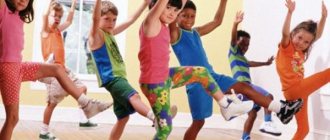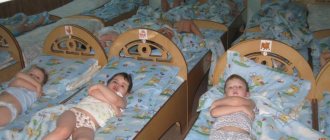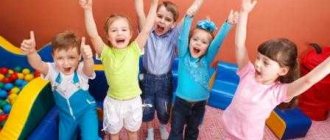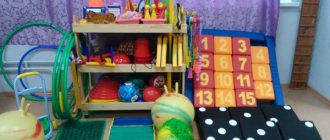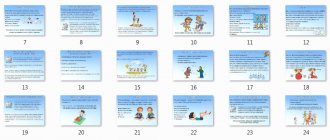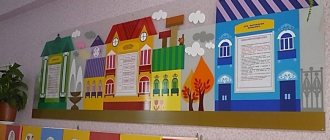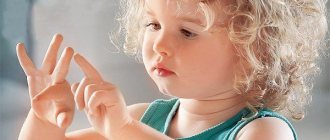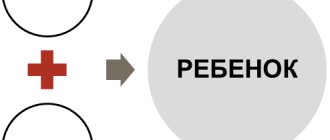Goals of eye gymnastics in a preschool institution
Visual gymnastics is one of the effective means of preventing eye diseases, as well as correcting existing problems. In kindergarten, it belongs to modern health-saving technologies (along with dynamic pauses, self-massage, breathing exercises, etc.).
It is interesting that the first exercises designed to maintain visual acuity were invented even before our era by Indian yogis. While creating complexes for the whole body, they did not forget about the eyes.
In a preschool institution, eye gymnastics is very important because it performs a number of tasks:
- General improvement of the visual system, prevention of various disorders in the functioning of the visual organs: strengthening the eye muscles, relieving tension, preventing fatigue, improving blood circulation in the eyes.
- It is an effective addition in the treatment of existing diseases: childhood myopia, farsightedness, astigmatism.
- Forms in pupils ideas about the importance of taking care of their health, in particular, about the organs of vision. The children learn about the value of vision.
- Has educational value. By performing visual exercises, children learn to navigate in space: they reinforce the concepts of “right” and “left,” “up” and “down,” and “turn.” In addition, performing gymnastics contributes to the development of coherent speech, enrichment of vocabulary, and reinforces familiar concepts about the structure of the world around us.
Visual gymnastics teaches preschoolers to take care of their eyes and understand the value of vision
Indeed, visual gymnastics is very important when working with modern preschoolers. Working as a kindergarten teacher, on Mondays I often talked with the children about what they did over the weekend. Many enthusiastically began to retell the content of the cartoon or computer game they had watched. In the preparatory group, some children even brought mobile phones and tablets with them to kindergarten, gathering a group of peers around them. All together they began to look at the screen with a flashing image. Of course, I stopped such “games”. By the way, it is interesting that according to the stories of many children, parents also spend a lot of time at home, straining their eyesight: TV, social networks, etc. (“Mom was on the phone all day”).

TV, computer and mobile phones from an early age have a detrimental effect on the vision of preschoolers
Why does children's vision deteriorate?
Vision is one of the five physical senses that allow a person to perceive and understand the world around him. But a newborn is only able to see fluctuations of light and shadow. His poor vision is due to incomplete formation of the fundus retina. But every day, thanks to strengthening vision, the baby receives more and more information. However, it is worth understanding that children grow up in conditions where they cannot be protected from harmful influences. Cartoons, television, and educational computer games that are useful for children's development have long become an integral part of the life of any preschooler. You can talk for a long time and without success about the dangers of a computer and TV, but it would be wiser to simply adapt to them and other current circumstances. It is in such conditions that you need to learn to protect your eyesight. It is paradoxical that with daily eye training, vision can still weaken. Doctors have long pointed to a sharp increase in the number of diseases of the visual organs.
Types of visual gymnastics in preschool educational institutions
Several types of visual gymnastics are practiced in kindergarten:
- Without attributes (exercises are simply performed according to the teacher’s verbal instructions) and with objects and visual aids (children follow with their eyes a moving toy, “run” their eyes along the indicated trajectory, etc.).
- Preventive (aimed at preventing the development of eye diseases) and corrective (slows down the development of myopia, farsightedness, astigmatism, etc.).
- Passive (only exercises for the eyes) and active (combined with general developmental exercises, using the muscles of the arms, legs, back, etc.).
It is advisable for the teacher to conduct various types of eye gymnastics with preschoolers, alternating them wisely.
The benefits of eye gymnastics
Visual exercises can be a great help in maintaining good vision. The main task of such gymnastics for preschoolers is to create in children the concept that vision also needs to be taken care of. With the help of physical education, including regular eye exercises, you can increase their performance, improve blood circulation, and prevent the development of some eye diseases. In addition, the educational material will be better absorbed. Elementary eye gymnastics exercises should be used at an early age. A one-year-old baby perceives a five-minute session with her twice a day as a game. The easiest way is to close and open the eyelids (it turns out dark and light), rotate the pupils in a circle (the mother moves the toy in a circle, and the child watches the last one). After your child masters these exercises, you can move on to more complex ones. At 3 years old, the baby willingly does what he is asked: articulates, grimaces.
Methods of visual gymnastics
Visual gymnastics is carried out from a very early preschool age. You should do healthy exercises with your children two to three times a day. The duration of classes in the junior and middle groups is two to three minutes, in the senior group - four to five minutes.
When performing exercises, you must follow certain rules:
- Guys must stand or sit. At the same time, you should not strain your body.
- The head takes a fixed position (unless, of course, the gymnastics is active - it is not combined with head turns to strengthen the neck muscles).
- If some children wear glasses, they should be removed.
- Baby's breathing should be uniform and deep.
- The last exercise is best done by blinking, and after finishing the gymnastics, it is advisable for kids to stretch well.
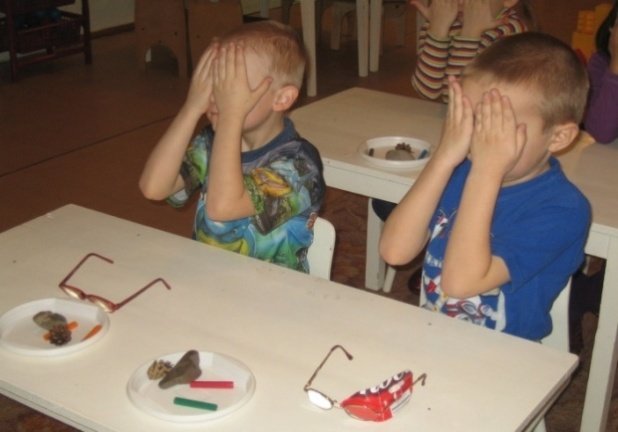
Glasses must be removed during eye exercises.
To arouse the maximum interest of preschoolers in eye exercises, it should be carried out in a playful way and use imagery. For example, you can not just ask children to close their eyes tightly, but turn into eagle owls or cats who have just woke up. In addition, the children always like to do exercises accompanied by funny poems.
You can do visual gymnastics at any time: while walking, in your free time, or organically include it in any activity (cognition, speech development, productive activity). At the same time, the topic of exercise is connected with the topic of educational activities directly. For example, if children study insects, then the children can follow the flight of a toy bee with their eyes. If during the actual educational activity we are talking about transport, then you can offer an exercise with a short poem:
- They rush through the city from morning until night
- Cars of all brands, very beautiful.
- They will go left, right, around -
- Cars are free both night and day.
At the same time, children perform eye movements according to the text (left, right, circular), and at the end they blink.
If the lesson is associated with eye strain (productive activity), then eye gymnastics is carried out in the middle of the lesson. If the educational activity itself does not involve a load on the eyes (speech development, reading fiction), then a separate exercise for the eyes can be done in the second half of the lesson: the children will receive a kind of relaxation and will be able to get a little distracted.
You can find a lot of ideas for visual gymnastics while walking. For example, a teacher invites preschoolers to look down at the grass, then up at the sky, look for birds there, then back at the grass. In the warm season, you can watch a butterfly flapping its wings and offer to wave its eyelashes.
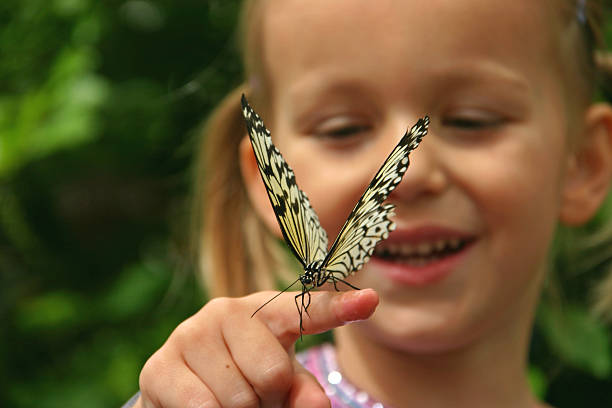
You can find a lot of ideas for visual gymnastics while walking
You can train children's eyes in your free time, in the morning or evening. The teacher offers the children ophthalmic simulators or specially alternates certain games: sorting small objects by shape or color (the muscles of the eye responsible for near vision work) and throwing balls into a basket or skittles (while the child looks into the distance). In sunny weather, you can use an ordinary mirror and chase sunbeams around the room: the kids will follow them with their eyes.
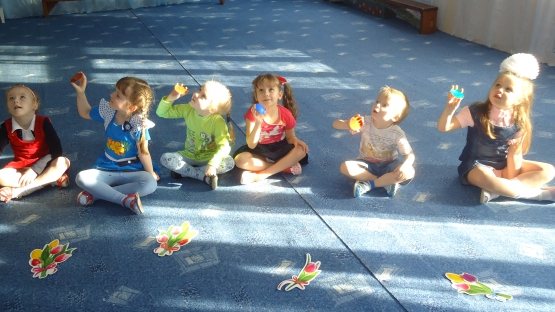
You can train your visual muscles even with the help of ordinary sunbeams
Features of working with preschoolers of different ages
When organizing gymnastics, it is important to take into account the age of preschoolers. For example, two-year-old children are unlikely to understand the verbal command “rotate with our eyes”: the teacher must use an object that the children will follow with their eyes. Moreover, it should not be an ordinary pencil, but a “magic wand” or a pointer with a picture or toy attached to it. An interesting idea is to put on a finger puppet.
Another effective way to interest a younger preschooler is phrases like “Can you do that? But I can do it!” After such words, inquisitive little ones are ready to repeat everything after the teacher.
Forcing a small child to do something if he is not interested is unacceptable and, moreover, will not bring any benefit.
As for the older preschool age, here you can motivate the children with an educational conversation: tell them about the structure of the human eye, about the need to care for it. Curious students will also be interested in learning the differences in the structure of the human eye and various animals (for example, a crocodile’s eyes are located on the sides of the head and have three eyelids). The teacher should discuss with children how harmful it is to watch cartoons and sit for long periods of time playing computer games. After such a conversation, preschoolers themselves will want to do useful exercises.
If, when conducting visual gymnastics with younger preschoolers, the teacher must demonstrate each exercise himself and do it together with the children, then at the senior level the teacher only needs to demonstrate the execution of the actions once. In the future, verbal instructions or reading a poetic text (if it accompanies the exercise) will be sufficient.
Stereo pictures to relax your eyes
Looking at stereoscopic images in itself is interesting, since a three-dimensional image appears on a flat sheet. All you need to do is select images with a children's theme. You can start with the game “Guess who is hiding in the picture.” The next day, add another one to the initial set of pictures (5-6), and the baby must remember who was not in the pictures yesterday. You need to make sure that the child blinks when looking at it. It is better to use paper pictures rather than those presented on the monitor. With this exercise, attention, imagination, and the ability to navigate spatial geometry will simultaneously develop.
Examples of exercises
When conducting gymnastics with younger preschoolers, the exercises should be extremely simple, but at the same time entertaining. You can use the following options:
- "Pussy eyes." The teacher asks the kids to imagine themselves as kittens. Children open their eyes wide and then close them. After that they look up, down, to the side.
- "Swing". The teacher invites the children to play with their eyes on a swing: fly up high and then fall down (moving their eyes up and down).
- "Carousel". Circular movements with eyes.
- "Day and night". The child holds his finger in front of him at arm's length. At first he looks at him with both eyes, then only with the right one while the left one is closed and vice versa.
- "Hide and seek." The guys need to close their eyes tightly for a couple of seconds, and then open them for the same amount of time (the motivation is “you’re hiding and no one can see you”).
- "Clothespin." Using the thumbs and index fingers of both hands, you need to squeeze the skin between the eyebrows (as if holding it together with a clothespin).
- "Butterfly". The teacher invites preschoolers to blink their eyelashes, like a butterfly flaps its wings.
Starting from middle age, exercises should be more complicated:
- "What changed?" While walking, invite the children to look into the distance at the children from the neighboring playground or at the passers-by from the group window and remember their location. Then the kids close their eyes for about 10 seconds, and then say how the location of the people has changed.
- "Geometric figures". The teacher asks preschoolers to imagine a large circle, and then circle it with their eyes clockwise and counterclockwise. Similarly, you can “draw” a square, and then move your gaze from the upper right corner to the upper left, etc.
- “We make faces.” The teacher invites the children to portray an animal, for example, a hedgehog. At the same time, it is stipulated that he stretches his lips forward, and his eyes “run” left and right, then up and down.
- "Expansion of visual fields." The child places the index fingers of both hands directly in front of him. Each finger is watched by its own eye. Then the fingers slowly spread apart, and the eyes continue to follow them.
- "Pinocchio." The guys look at the tip of their nose. Then the teacher counts to 5 (in the senior group - up to 10, in the preparatory group - up to 20) and asks the children to imagine that their nose is growing. They should follow its tip with their eyes - it seems to be moving away from them. After this, preschoolers also observe its decrease.
- "Shooting with the eyes." The child suddenly turns his gaze in any direction and says “bang-bang.”
In addition, from a young age you can perform visual gymnastics to a poetic text. At first these are short works, then longer ones. You can use the following options:
Table: "Bump"
| One day in the fall there was a pine cone hanging in the forest in plain sight. The cone looked at everyone and hung quietly. | Look at the index finger of an outstretched hand |
| Moose said it was low | Downward eye movements |
| And the little bunny is high, | Eye movements upward |
| Squirrel said - close, | Movement of the eyes to the tip of the nose. |
| And the hedgehog is far away. | Eye movements into the distance. |
Table: "Vegetables"
| The donkey walks around, chooses, and doesn’t know what to eat first. | Circle your eyes |
| The plum is ripe at the top, | Look up |
| And nettles grow below, | Look down |
| On the left - beets, on the right - rutabaga, | Look left-right |
| On the left is a pumpkin, on the right is a cranberry, | Left - Right |
| Below is fresh grass, | Look down |
| On top there are juicy tops. | Look up |
| I couldn’t choose anything and collapsed on the ground without strength. | Close eyes |
Table: “Christmas tree”
| There is a big Christmas tree, this height. | View from bottom to top |
| It has large branches that are this wide. | View from left to right |
| There are even cones on the tree, | Look up |
| And below is the bear’s den. | Look down |
| The clubfoot sleeps there all winter and sucks his paw in the den. | Close your eyes, then blink 10 times |
The following examples refer to active visual gymnastics (it is accompanied by body movements) to a poetic text.
Table: "Rain"
| The first drop fell: drip-drip And the second ran: drip-drip | Tap your finger on your palm |
| We looked at the sky | Look up |
| The droplets began to sing drip-drip | Knock on the head |
| Our faces got wet, we wipe them | Rub your face and eyes gently |
| Shoes - look | Look down at your feet |
| They became wet | Point to feet with hands |
| Let's move our shoulders together and shake off all the droplets | Shake your shoulders |
| Let's run away from the rain | Running in place |
| Let's sit under a bush | To squat |
Table: "Spring"
| Everything has woken up from sleep, which means spring has come to us. | Sipping |
| The sun is getting warmer, let's go for a walk soon! | Throwing the fingers out of the fist while simultaneously spreading the arms to the sides |
| On the right - the first flowers appeared on the meadow. | The right arm is moved to the side while fixing the direction with the gaze |
| On the left is a fast stream from a hillock to a drip. | The left arm is moved to the side, fixing the direction with the gaze |
| We made a boat | Place your palms in front of your chest |
| They decided to let it into the stream. | Removing folded palms forward from yourself |
| Sail away, my little boat, straight to the blue river! | We wave our palms, saying goodbye to the boat |
| This is how fun it is to play and walk on a spring day! The earth breathes freshness, I will breathe “spring” too! | Light bouncing in place |
Table: "Cat"
| Now the window has opened, | Spread your arms to the sides |
| The cat went out onto the ledge. | They imitate the soft, graceful gait of a cat. |
| The cat looked up. | Looking up |
| The cat looked down. | Looking down |
| Here I turned to the left. | Looking left |
| She watched the flies. | The gaze traces the “fly” from the left shoulder to the right |
| She stretched, smiled and sat down on the ledge. | Children squat. |
| She turned her eyes to the right and looked at the cat. | They look straight |
| And covered them with her hands. | Cover your eyes with your hands |
Video: a teacher conducts visual gymnastics with preschoolers
Video: girl doing eye exercises (7 exercises)
The influence of gymnastics, effect
You need to understand that if a child has a disease that causes decreased vision - myopia, hypermetropia, astigmatism - he needs constant vision correction with glasses or lenses. However, many years of practical experience have proven that with mild and moderate myopia, general strengthening measures and exercises (gymnastics) for the eyes contribute to:
- improving blood supply and nutrition of eye structures;
- eliminating eye strain and quickly “unloading” it;
- reducing the possibility of ciliary muscle spasm or reducing its degree;
- strengthening the external muscles of the eye;
- strengthening the sclera (outer shell of the eye), which has a stabilizing effect, eliminating changes in the size of the eye as myopia increases.
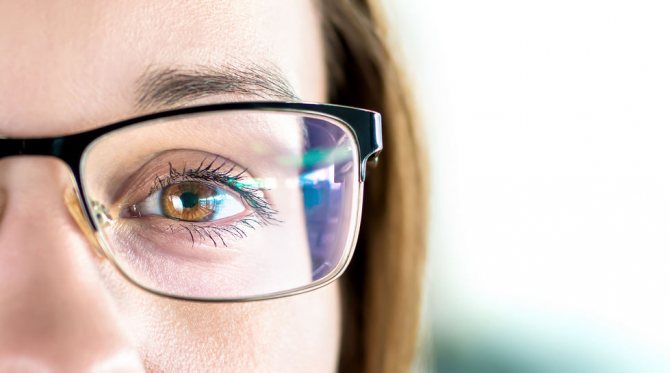
Using visual aids during visual gymnastics
When performing visual gymnastics, visibility is of great importance. It helps to interest children and make exercises more effective. After all, in preschoolers (especially at a younger age), visual-figurative thinking predominates, and many exercises, especially such as rolling the eyes, turning the eyes, are much easier for them to do with a visual reference in front of them.
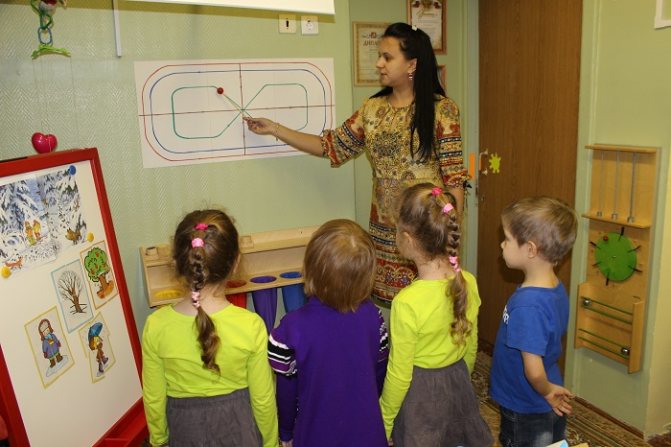
Many exercises are easier to perform when there is a reference point in front of your eyes.
The following types of visual aids are used to conduct gymnastics in kindergarten:
- Guide items. They are distributed to all children or the teacher shows the object to a group of children. In the first case, each preschooler holds a small object in front of him (for example, a hair tie with a butterfly, it is convenient to put it on his finger) and moves it according to the teacher’s instructions. At the same time, the gaze follows him. Such things are again selected according to the topic of the lesson (the mentioned butterfly elastic band will come in handy, for example, when studying the topic “Insects”). In any case, the object should be large enough and bright, not blending in color with the teacher’s clothes and the surrounding environment. The simplest version of such a visual reference is a colorful magic wand (pointer). You can also use finger puppets. You can attach a picture to the end of it. When the teacher shows the landmark, he places the kids with lower visual acuity closer to him, while the rest sit or stand behind.
- Scheme. Such manuals are intended for older preschoolers, because they are already developing abstract thinking. They show different types of eye exercises. Looking at the picture, the child can understand exactly how to perform the actions.
- Signal marks. They are designed for exercises when the gaze switches from a near point to a far point. A mark with a diameter of about 0.5 cm is attached to the window glass at eye level of the preschooler. The child stands very close to her (distance - approximately 20 cm). He should look at the landmark for a couple of seconds, and then turn his gaze to a distant point on the street. The teacher asks the preschooler to tell him what interesting things he sees there.
- Wall-mounted and ceiling-mounted ophthalmic simulators. This is a kind of trajectories along which children's eyes “run”. For example, from one animal or fairy-tale character you need to get to another along a bright (usually broken) path. At the same time, the child’s head and torso may move. Each track has its own color. Exercises are usually performed collectively.
- Individual ophthalmic simulators. They are outline pictures of many individual small elements - butterflies, leaves, Christmas trees, etc. (at an older age, these can be letters or numbers). The child should visually trace the outline; you can also help with your finger. In this case, the preschooler holds the picture in front of him at arm's length.
Photo gallery: visual aids for performing visual gymnastics
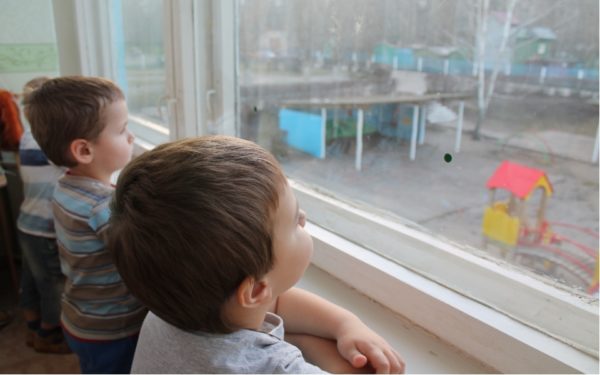
The signal mark is needed to switch gaze from a near point to a far point
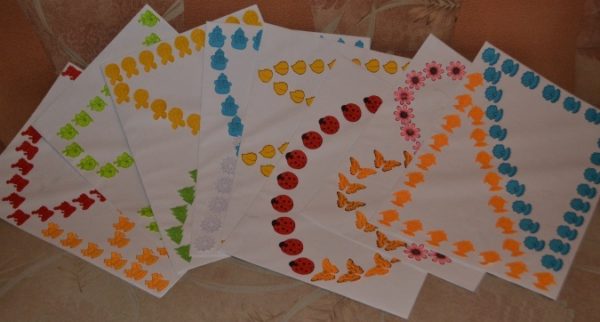
The simulators are designed for individual work
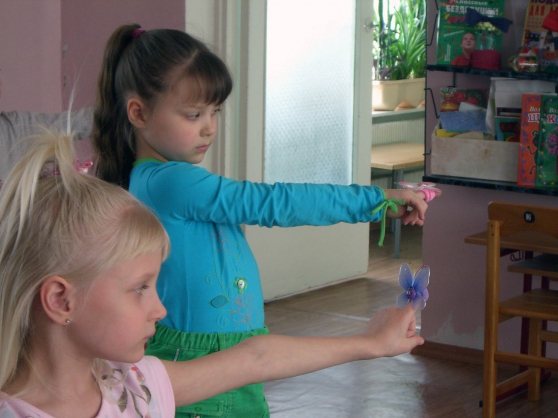
The child moves the object according to the teacher’s instructions and follows it with his eyes
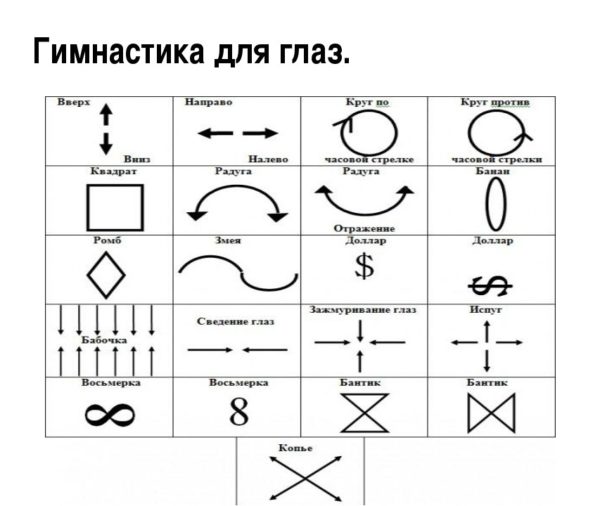
The schemes are designed to work with older preschoolers
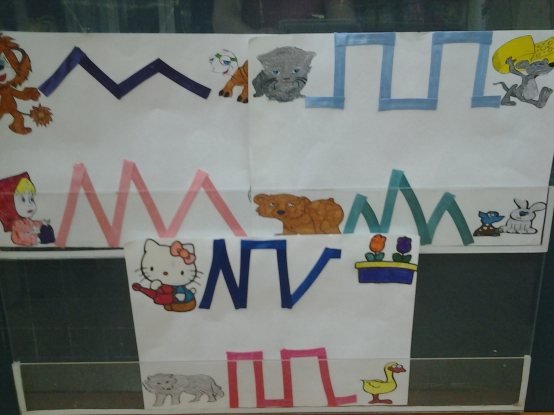
Children should visually trace the path from one character to another
Video: preschoolers perform eye exercises (an exercise with a visual reference - a homemade flower)
The teacher can easily make almost all the attributes for visual gymnastics with his own hands. So, a simple but original guide is Cheburashka with moving eyes (it can be any other character). It is cut out of colored cardboard. With the help of such a toy, you can not only strengthen your eyesight, but also repeat mathematical concepts (“in which direction is the character looking?”).
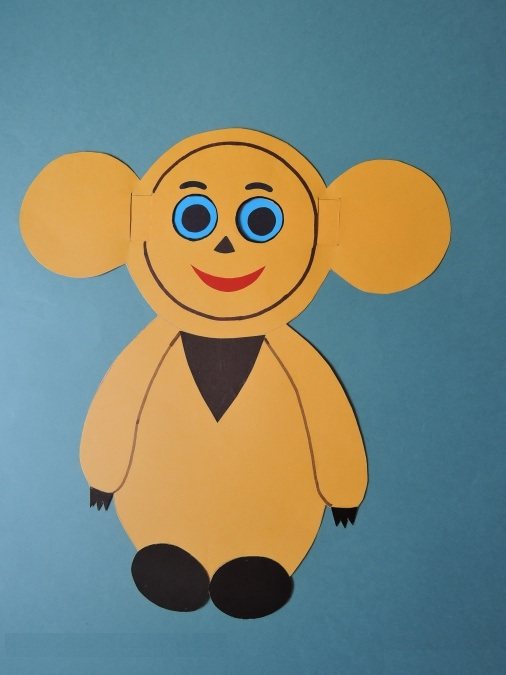
Due to the slits, Cheburashka's eyes move
Even pupils of the younger group can repeat the eye movements of such a Cheburashka - it replaces the teacher’s demonstration.
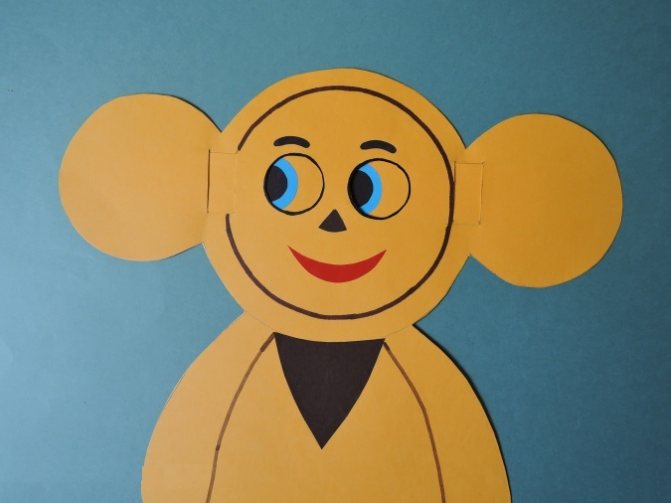
When working with children, Cheburashka’s actions replace the teacher’s demonstration
Another example of a homemade manual is geometric shapes cut out of colored cardboard (all of them are different colors). They are mounted on the wall at a sufficient distance from each other. The teacher chaotically names the figures or their color, and the children must look from one object to another without turning their heads.
An interesting guide is “The Orchard”. The poster shows various fruits: they form circles (small ones inside larger ones). The teacher names a specific fruit, and preschoolers must circle the corresponding circle with their eyes.
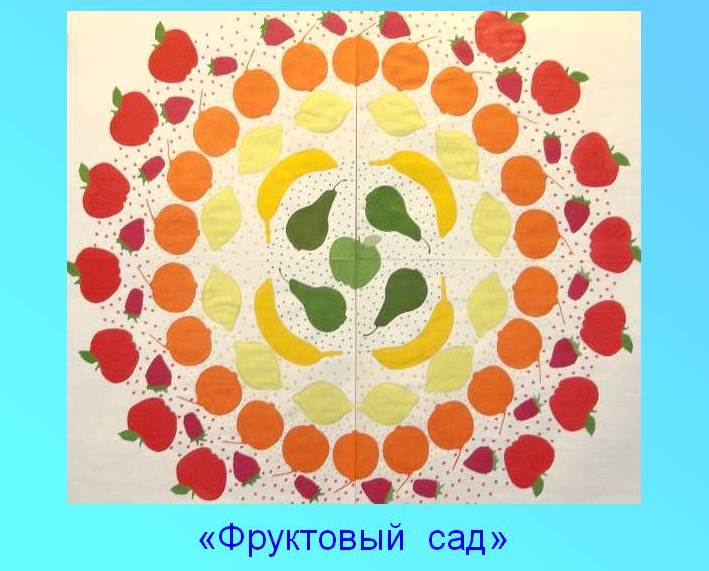
Fruits are arranged in circles of different sizes
Visualization should also be used when working with parents. Special posters showing how to correctly perform visual gymnastics should be periodically placed in the health corner in the locker room. Moms and dads can look at them there, and they will definitely attract children's attention.
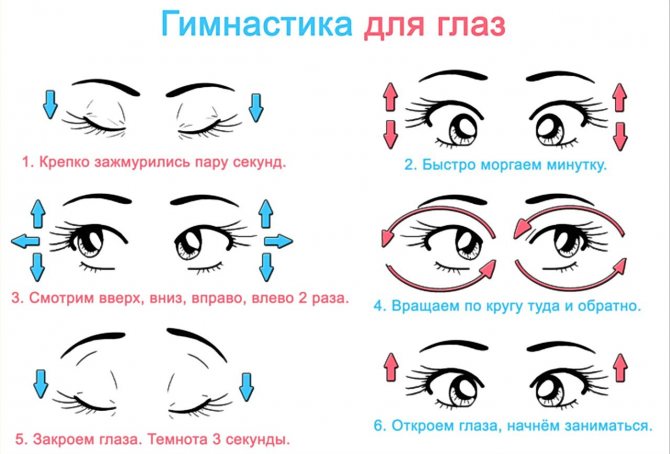
Using the poster, parents will be able to familiarize themselves with the rules for performing visual gymnastics
Multimedia aids
Preschoolers always really like multimedia aids for visual gymnastics. They are videos where various objects appear on the screen: fish in an aquarium, butterflies in a meadow, stars in the sky, etc. The kids’ task is to follow them with their eyes. All this happens to the accompaniment of pleasant music, causing extremely positive emotions in the children.
Video: sunshine
https://youtube.com/watch?v=LzbmJRaD4s8
Video: butterfly
Video: starry sky
Video: balloons
Video: geometric shapes
Video: in the depths of the sea
Video: watching the figures
Video: rainbow
Execution method
The exercises are designed to strengthen the optic nerves.
- Eye movements are made to the right and left, in a circle, to the sides horizontally. You can use a pencil as an auxiliary element. The child looks at its tip and follows the movement.
- Exercise with a point . Draw a red dot on the window glass. It should be at the child's eye level. We invite the preschooler to look at the dot for 5 seconds, then move his gaze beyond the window to some distant object.
- Blinking . Relaxes vision, relieves fatigue by blinking quickly for a few seconds.
- Cover your eyes with your palms . Our eyes rest well in the dark, but, unfortunately, it is difficult for us to get rid of light entering the retina: even at night, the light of flashlights can interfere. If you tightly cover your eyes with your palms, the light does not fall on them, and the eye muscles relax.
- Let's keep an eye on the subject . In addition to a pencil, you can suggest keeping an eye on any bright object. It is better if it is of a simple shape: a cube, a ball, a candle.
Eye trainer on computer
Modern gadgets can not only worsen your vision, but can also help your eyes rest. There are a number of different ophthalmic applications for smartphones that are designed to relax and rest the eyes.
There are also a number of graphic programs for vision and computers. The patient is seated in front of the monitor and special programs are turned on.
One of the most common eye trainers on the computer are illusions, repeating patterns and endless mazes. The patient should watch the center of the screen and not be distracted. The activity often greatly relaxes the patient; small children can fall asleep near the monitor.
Bates Eye Trainer
The method of vision restoration proposed by the American ophthalmologist Bates has been helping to restore vision for 100 years. The technique was at times prohibited; doctors proved it was not effective. But many people successfully use Bates eye simulators and are satisfied with their results.
The Bates simulator is a spectacle frame with LEDs inserted into the glasses. Wires and a control panel are attached to the outside. The patient puts on glasses, turns on the simulator, and treatment with light pulses begins. The device has several operating modes, the session lasts 15 minutes, the timer is located in the device itself and turns off after the time has elapsed.
The simulator is carefully fixed not only on the bridge of the nose, but completely on the head. The eyes must be closed, the body relaxed and in a comfortable position. While the massager is operating, the patient's intracranial pressure normalizes, eye fatigue is relieved, and visual acuity increases.
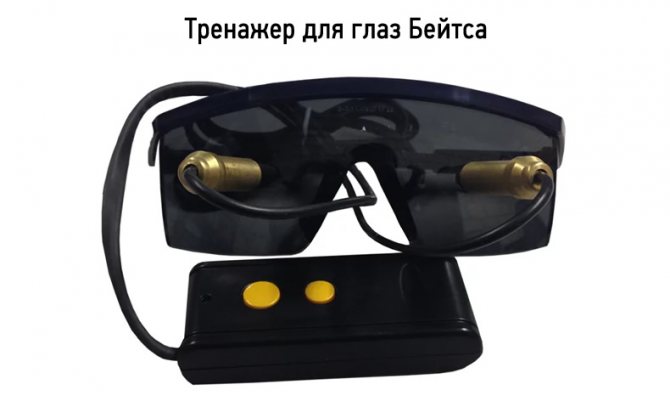
Eye massagers
The trainer is a powerful pair of glasses that attach well to the head and massage the large area around the eyes. The eye contact area is equipped with additional massage tentacles. There are magnets between them; the device additionally provides stimulation with magnetotherapy.
The massagers are connected to the network and have a control panel. Often the devices have a timer; the procedure should last no more than 15 minutes. After switching on, a slight vibration begins. Before the session, it is better to take a comfortable position; you cannot walk with the device, and it is best to relax, reclining.
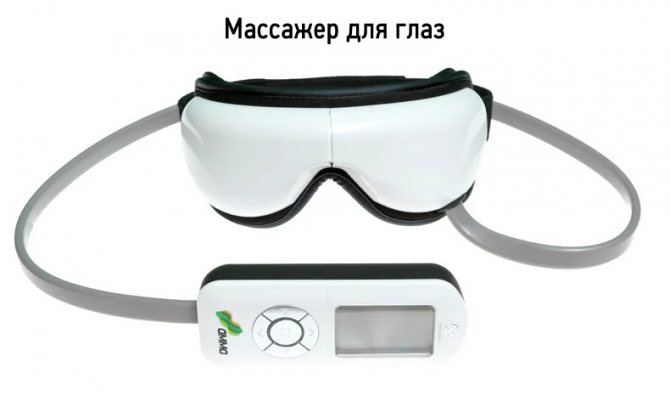
Bazarny eye trainer
Russian scientist V.F. Bazarnov studied the eye health of schoolchildren for many years and developed a unique simulator. You can make it yourself, and if you use it for a long time, you can do without it.
Ophthalmologists note the good effect of the simulator. It was also highly rated by neuropsychologists. Working with the simulator every day improves grades in school, children begin to concentrate better on tasks and understand better in logical problems.
The Bazarny eye simulator itself is a drawing on the wall or ceiling of 3 multi-colored lines. In the center is a large horizontal figure eight or an infinity sign, for example green. The second line is oval, slightly larger than a figure eight, green. The third line completely repeats the second, slightly larger in diameter and red in color. {banner_horizontalnyy2}
Often these three figures are applied to a standard sheet of Whatman paper. It is attached to the wall or ceiling so that the patient can examine all the lines while standing. They find a point from which they begin to repeat the figure eight with their eyes, then both ovals. It is difficult for small children to concentrate and not lose the line; you can help yourself with your finger, pen or pointer.
There are no contraindications, unless you feel generally unwell. Usually everyone enjoys doing the exercises. It is recommended to do 1 approach every day 20 times along each line, or before complex work where concentration is required.
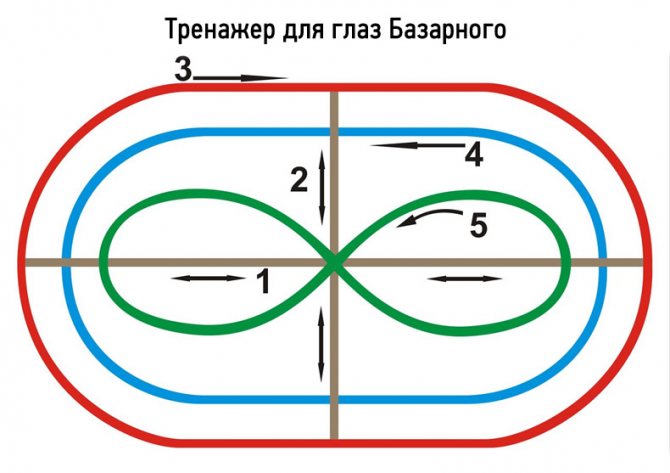
Other sets of exercises for children with myopia
Bates complex
Literature about the system of William Horatio Bates and his student M. Corbett, the creator of non-drug treatment for refractive impairment of vision, based on the theory of accommodation due to the work of the oculomotor muscles and rejected by the world ophthalmological community in the 30s of the last century, like many other things, appeared in the Soviet Union during the period of "perestroika". The author of the work does not note that the developed system is intended for the prevention and treatment of myopia in children. There is no information about who and when this system was adapted for children in our country.
One of the cornerstones of the theory is to achieve complete relaxation of the extraocular muscles through autotraining (meditation), the so-called. “palming”, the technique of which probably will not be able to be mastered by a child of preschool and primary school age, because And it’s not easy for an adult to do this. Today, on the Internet, even on behalf of very well-known ophthalmological clinics (private), a large number of different variants of this system are presented, in which “palming” is reduced to simply closing the eyes with the palms of the hands. And without it, training according to the W. Bates system does not work. It is alarming that none of the authors offering the most well-known variants of exercise complexes using “palming” in the Russian Federation is an ophthalmologist.
In the Western world, there is a modification of the W. Bates system, proposed by M. Windolf, based on “palming”. But it is believed that the use of this method can cause stress and discomfort in the child; it has contraindications. There is no statistical data on the effectiveness of the W. Bates system. The following reliable fact deserves attention. One of the friends and ardent promoter of the W. Bates system, the famous novelist Aldous Huxley, demonstrating to the public his “victory” over “senile farsightedness,” read the text at close range, without using glasses, and suddenly fell silent. History is silent about how he got out of this situation. Later, in a private conversation, O. Huxley admitted that he had forgotten the text he had learned by heart.
Hardware treatment
To carry it out in domestic ophthalmology, many techniques have been developed. From classical physiotherapy (electrophoresis with medications, electrical stimulation of the ciliary muscle and optic nerve) to devices based on magnetic and laser effects.
For hardware treatment, the Visotronic device is sometimes used. Additionally, there are several computer programs that can be used to improve children's vision. Please note that we are talking about domestic developments. The fact is that until recently, Western practical schools did not consider myopia as a disease, but only as a visual condition that needed correction. Hardware treatment also has disadvantages. And first of all, these are the costs associated with regular visits to a medical facility. Secondly, the lack of a stable and long-term effect. You can hear your opinion on this matter in this video.
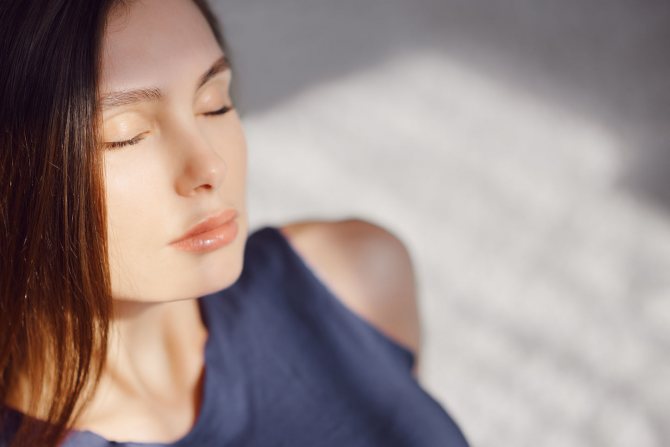
Eye exercises with simulators
There are also a lot of techniques in this section. The most famous are optical simulators and so-called “perforation glasses”. In the first case, combinations of glasses with a certain lens strength are used for training; in the second, a ruler with prisms of different strengths is used. Both methods are based on research. In the third option, against the backdrop of massive advertising, there is no clear understanding of the operating principle of this device, as well as statistics on its effectiveness. Like all of the above, exercise machines do not provide a permanent effect.
Exercises for preschoolers
The eye exercises for myopia given above are suitable for preschoolers as preventive measures.
It can be difficult for young children to understand what exactly their parents want from them, so adults are recommended to do the exercises with them. In this case, you should help small patients - for example, draw shapes with your fingers or trace them on cards.
You can use almost any object in the house to exercise with children.
For example, ask your child to look around the outline of the furniture. Or put stickers with figures on the walls and furniture and ask your child to look for the desired figure without turning his head. At the same time, the figures may differ in color, which has a positive effect on vision training.
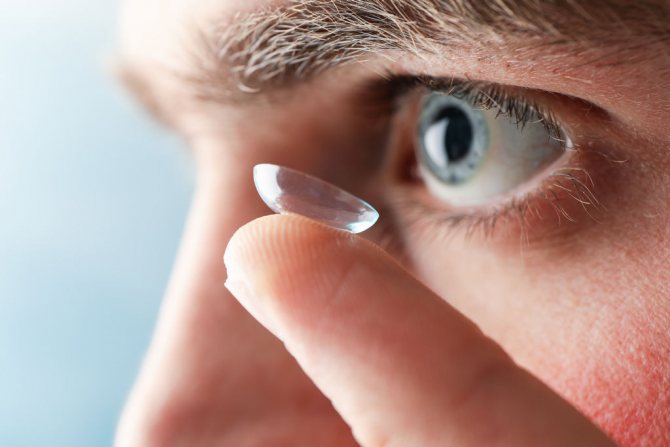
Eye training glasses
Eye training glasses are produced in the form of regular glasses in a classic frame with black plastic instead of glass. The entire surface is pierced with holes in a certain order. Those who put on glasses for the first time surprisingly note that they get by just fine without glasses with diopters.
The holes in the lenses are not simple: conical and cylindrical. The number of holes depends on the model, in some the lens is completely covered with holes, in others in a certain order. This does not change the quality.
After putting on training glasses, the perception of light and its sharpness changes. Perforation promotes proper distribution of the load, forcing the eye to work fully.
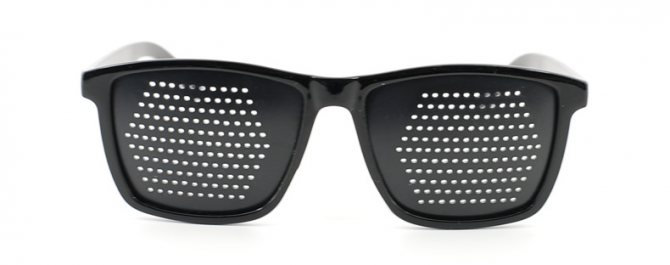
Recommended for:
- age-related changes;
- difficult work, when the eyes were strained for a long time;
- initial stage of cataract, strictly after consultation with an ophthalmologist;
- astigmatism, myopia and amblyopia.
It is recommended to wear up to 2 hours a day. You can divide it into 3-4 times, for example, 30 minutes in the morning, and 1 hour in the afternoon and evening. It is difficult to focus on complex visual work with glasses; it is better to do what you do well and confidently without glasses: cook, watch TV, work in the garden.
Contraindications include complex eye diseases, headaches, and intracranial pressure. In any case, if glasses are uncomfortable, they should not be worn.
Don't forget about visual hygiene!
A very important point in prevention is compliance with the rules of visual hygiene during visual stress at close range: prolonged reading and working with a computer. Breaks of 5-10 minutes every 30-40 minutes are required to perform the exercises. There must be sufficient lighting of the workplace (on the left side, not in the eyes, but on the table surface and not too bright), the correct position of the child’s body (without bending to the sides) in the workplace, maintaining a distance from the eyes to the object of visual work (30- 40 cm). Some recommendations for working with electronic devices:
- When using gadgets (for example, e-books), you should set the maximum font size everywhere.
- You should not read or use gadgets in low light; it is best to do this in diffused natural light.
- After every 15-20 minutes of working at close range, preschoolers and children of primary school age should perform the “Mark on Glass” complex.
- Don't forget about 2-hour walks in the fresh air with active games (especially those where the child needs to follow the ball, shuttlecock, focusing his vision on moving an object near and far).
- A proper diet without fasting or dehydration has a beneficial effect on the condition of the eyes. It is also recommended to include foods high in vitamins A, E and C and containing zeaxanthin and lutein.
Remember to take a comprehensive approach to preventing and treating myopia.
Nothing in this article should be construed as medical advice or replace the advice of a healthcare professional. For specific questions, please contact your ophthalmologist.
Literature : 1. E.S. Avetisov. “Myopia,” M. Medicine, 1986, pp. 208-229. 2. E.S. Avetisov. “Children’s vision protection” - M. Medicine, 1975, pp. 60-89. 3. E.S. Avetisov, E.I. Livado, Yu.I. Kurpan. “Physical training for myopia.” - M. Physical culture and sport, 1983 4. G.G. Demirchoglyan, A.G. Demirchoglian." Special physical education for visually impaired schoolchildren.” M. Soviet sport. 2000 pp.118-137. 5. Baranov A. A. Assessment of the health of children and adolescents during preventive examinations / A. A. Baranov, V. R. Kuchma, L. M. Sukhareva. - M.: Medicine, 2005. Pp. 8-17.
photo: Shutterstock
